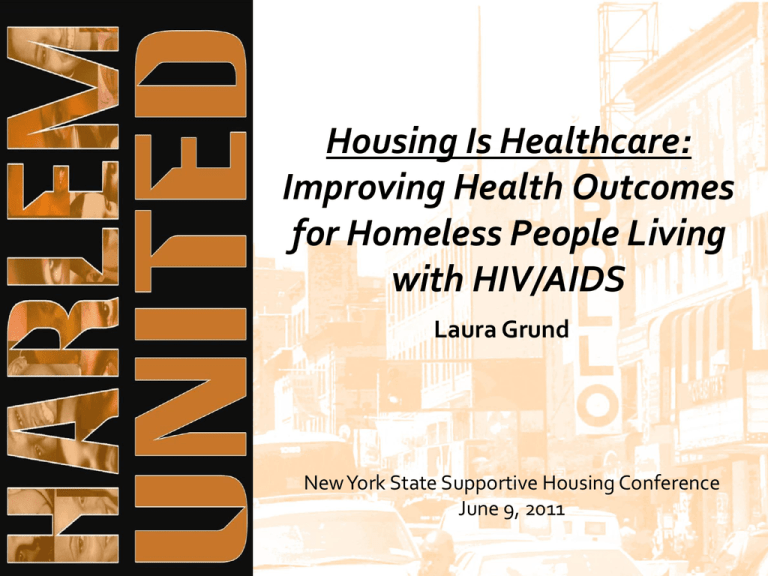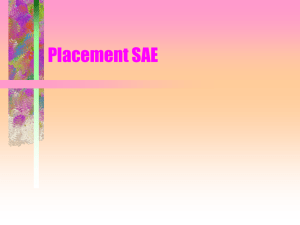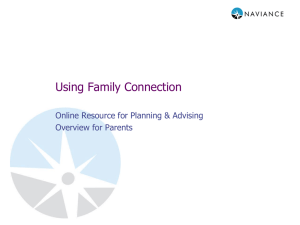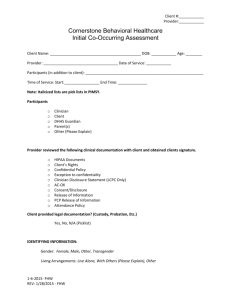PowerPoint - Supportive Housing Network of New York
advertisement

Housing Is Healthcare: Improving Health Outcomes for Homeless People Living with HIV/AIDS Laura Grund New York State Supportive Housing Conference June 9, 2011 Overview of Presentation Presentation Overview • • • • • • Harlem United Housing= HIV/AIDS Healthcare Foundation House West NY/NY III Client Profile Questions 2 Harlem United • “One-stop shop” with integrated medical, housing, prevention, and supportive services for PLWHA • Our mission: to provide 100% access to care and to obtain zero disparity in health outcomes caused by socioeconomic barriers • 558 units of housing for adults and families living with HIV/AIDS (plus HIV primary medical and dental care [FQHCs], psychiatry, mental health, substance use, adult day health care, intensive case management, Voc Ed employment services and prevention services) 3 HOUSING = HIV HEALTHCARE • Studies show strong correlations between improved housing status and… – Reduction in HIV/AIDS risk behaviors – Access to education and prevention – Improved health outcomes – Savings in taxpayer dollars • Reduced utilization of emergency & inpatient services, lower overhead costs compared to shelters and other emergency housing services • Savings have been found to offset up to 95% of the cost of supportive housing (findings from “National Housing & HIV/AIDS Research Summit Series” – The Johns Hopkins Bloomberg School of Public Health) • Harm reduction-based housing services increase routine utilization of medical care, improve medication adherence and health outcomes, and increase rates of employment among our clients 4 Foundation House West • 25 congregate units, single adults living with HIV/AIDS, histories of homelessness, chronic health diagnoses • Program mission: to assist residents in attaining personal medical and housing stability and independent living skills • Supportive case management; life skills services; vocational, employment and educational services; primary medical and home care referrals; entitlement assistance and advocacy; substance use assessment and Harm Reduction education and counseling; mental health assessment and counseling; etc 5 Demographics of FHW Demographics: Residents are predominantly male (88% male; 12% female) African American (63%); 33% Latin, and 4% white Median age of 46.3 All residents are triply-diagnosed with a history of substance use, 85% with a psychiatric diagnosis, 90% with another nonHIV related co-morbid condition such as diabetes, asthma, heart or lung disease 6 Hospital Utilization, Foundation House West Hospital Utilization Prior to and After Placement at Foundation House West 70% 60% 50% 40% 63% 54% 46% 42% 30% 20% 10% 0% ER V isit s 6 M o nt hs Pio r t o Placement ER V isit s 6 M o nt hs af t er Placement Ho sp it aliz at io ns 6 M o nt hs Prio r t o Placement Ho sp it aliz at io ns 6 M o nt hs af t er Placement 7 Hospital Utilization, Foundation House West Number of ER Visits Frequency of ER Visits Prior to and After Placement 7 6 5 4 3 2 1 0 5.87 1.46 Number of visits to the ER 6 Months Prior to Placement Number of visits to the ER 6 Months After Placement 8 Cost Benefit Analysis of Foundation House West The cost benefit of supportive housing for PLWH/A has been demonstrated by the decreased dependence and need for inpatient hospital care. Likewise, the decrease in FHW clients’ frequency of inpatient hospitalizations yielded overwhelming savings in comparison to the overall cost of this congregate program. Cost Cost Benefit Benefit of of Supportive Housing Supportive Housing Cost Cost of of Hospitaliza Hospitaliza tion tion Per Day Per Day Cost Cost of of Hospitalizations Hospitalizations Six Six Months Months Prior Prior to Placement to Placement at at FHW FHW Cost Cost of of Hospitalizations Hospitalizations Six Six Months Months After After to Placement to Placement at at FHW FHW Saving Saving offered offered by by Harlem Harlem United United FHW FHW Estimated Cost Estimated Cost $775 $775 $28,520 $28,520 $5,277 $5,277 $23,242 $23,242 9 FHW 10 NY/NY III Scattered Site Housing • 70 units of housing coupled with supportive services to chronically homeless single adults who are living with HIV/AIDS and cooccurring serious mental illness, substance use, or both • NY/NY III works with residents to stay healthy using a multidisciplinary team approach. The team includes Case Managers, a Nurse, a Vocational/Educational Specialist, and a Mental Health Specialist. All members of the team provide services to residents within their homes or in other community settings at least twice a month 11 NY/NY III Population Overview Demographics: Gender: 69% Male 24% Female 7% Transgender Race: 66% Black/African American 19% White 1% American Indian/Alaska Native 1% Multi-racial 13% unknown Ethnicity: 27% Latino/a Gender Male Female Transgender Race Black/African American White American Indian Multi-racial Unknown 12 NY/NY III Services include medical monitoring and medication adherence; mental health counseling and referral; substance use counseling and referral; life skills training including vocational, employment and educational services; apartment care and maintenance ; advocacy and case management; linking/referrals for legal assistance and other entitlements; escorts to medical, mental health, entitlements, and all other appointments; etc Utilizes multi-disciplinary model that incorporates aspects of an ACT team 13 NY/NY III 70% of clients classified as high risk and have some other serious illness or diagnosis; more than half (55%) present multiple risk factors requiring increasingly individualized multidisciplinary HIV/AIDS services Classification of High Risk Due to One or More of the Following n=150 16% Multiple Factors 8% Med-Psych 31% Med-Behavioral Substance 7% Psychiatric Illness 16% Behavioral SubstanceIssue 22% Medical Status 0% 5% 10% 15% 20% 25% 30% 35% 14 NY/NY III Substance Use & Adherence to Mental Health Treatment Comparison Between High and Low Risk Clients n=216 60% 50% 40% 30% 20% 10% 0% 50% 38% 27% Substance Use Not in care for MH Issue 19% 10% 1% % of High Risk % of Low Risk Clients Clients % of total Sample 15 Hospital Utilization, NY/NYIII Clients Assessment of NY/NYIII Utilization Emergency Room Visits (n=64) Average # of visits ER visits resulting in hospitalization Hospitalizations (n=64) Frequency of hospitalization Average length of stay Six Months Prior Six Months to Move-in After Placement 42% 27% 1.81 visits 1.12 visits 48% 53% 38% 25% 1.67 1.33 hospitalizations 7.13 days 9.42 days 16 [1] Cost of emergency room visits $832 hospital stay $1,891. Source of Emergency Room Cost based 2003 cost data from Medical Expenditures Panel Survey. Research and Quality January 2006. Source of Hospitalization Cost based on 2007 numbers from Agency for Healthc [2] ER Cost $832 x 49 ER visits = $40,768. Hospital $1891 x 226 days spend hospitalized = $427,366 [3] ER Cost $832 x 19 ER visits = $15,808 Hospital $1891 x 114 days spend hospitalized = $215,547 [4] Unit of Analysis is the total number of emergency room visits and the total number of days spent in the hospital prior to and then after program intervention. Analysis of NY/NY III Cost Benefit of A. Cost of Hospital B. Cost of Hospital NY/NYIII Visits Six Months Visits Six Months Prior to Placement After to Placement (ER Visits + Days in (ER Visits + Days in Hospital) Hospital) Estimated Cost $468,134 $231,355 C. Saving in reduced Hospital Visits by Program (Column A-B) $236,779 17 Client Profile • • • • CH was referred to HU Supportive Housing in July 2010 by his Case Manager at HU’s Adult Day Health Care West due to inadequate housing. At the time of intake, CH was four months sober and focused on remaining sober, returning to the work force and improving his relationship with his 12 year old daughter. CH was housed in September 2010 and immediately began to seek employment. Although the client is legally blind and uses a walking stick, he obtained full time employment as a Service Coordinator at a non-profit organization working with individuals with a history of substance use and homelessness. The client has a current goal of working towards his CASAC. Since obtaining his own apartment, the client has been able to take advantage of every other weekend visits with his daughter and have a home he feels comfortable sharing with her. He remains sober and says he is very happy with his job and looks forward to a future of employment and greater independence. 18 Policy Implications Take Aways… • Supportive Housing for PLWHA is Healthcare -- increases access to medical care, decreases acute care, improves health • Supportive housing as form of Prevention for those at risk (HIV negative, unstably housed); homelessness/eviction prevention • HU housing clients healthier, leading full and productive lives; emphasis on employment and ultimately moving on from supportive housing 19 Contact Information Questions? Laura Grund Vice President of Supportive Housing HIV/AIDS Treatment Support Services Harlem United Community AIDS Center, Inc. 306 Lenox Avenue, 3rd floor New York, NY 10027 (212) 803-2850 lgrund@harlemunited.org 20






